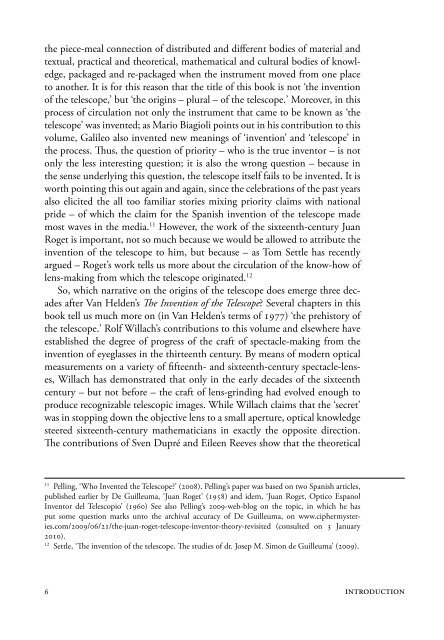The origins of the telescope - DWC - KNAW
The origins of the telescope - DWC - KNAW
The origins of the telescope - DWC - KNAW
Create successful ePaper yourself
Turn your PDF publications into a flip-book with our unique Google optimized e-Paper software.
<strong>the</strong> piece-meal connection <strong>of</strong> distributed and different bodies <strong>of</strong> material and<br />
textual, practical and <strong>the</strong>oretical, ma<strong>the</strong>matical and cultural bodies <strong>of</strong> knowledge,<br />
packaged and re-packaged when <strong>the</strong> instrument moved from one place<br />
to ano<strong>the</strong>r. It is for this reason that <strong>the</strong> title <strong>of</strong> this book is not ‘<strong>the</strong> invention<br />
<strong>of</strong> <strong>the</strong> <strong>telescope</strong>,’ but ‘<strong>the</strong> <strong>origins</strong> – plural – <strong>of</strong> <strong>the</strong> <strong>telescope</strong>.’ Moreover, in this<br />
process <strong>of</strong> circulation not only <strong>the</strong> instrument that came to be known as ‘<strong>the</strong><br />
<strong>telescope</strong>’ was invented; as Mario Biagioli points out in his contribution to this<br />
volume, Galileo also invented new meanings <strong>of</strong> ‘invention’ and ‘<strong>telescope</strong>’ in<br />
<strong>the</strong> process. Thus, <strong>the</strong> question <strong>of</strong> priority – who is <strong>the</strong> true inventor – is not<br />
only <strong>the</strong> less interesting question; it is also <strong>the</strong> wrong question – because in<br />
<strong>the</strong> sense underlying this question, <strong>the</strong> <strong>telescope</strong> itself fails to be invented. It is<br />
worth pointing this out again and again, since <strong>the</strong> celebrations <strong>of</strong> <strong>the</strong> past years<br />
also elicited <strong>the</strong> all too familiar stories mixing priority claims with national<br />
pride – <strong>of</strong> which <strong>the</strong> claim for <strong>the</strong> Spanish invention <strong>of</strong> <strong>the</strong> <strong>telescope</strong> made<br />
most waves in <strong>the</strong> media. 11 However, <strong>the</strong> work <strong>of</strong> <strong>the</strong> sixteenth-century Juan<br />
Roget is important, not so much because we would be allowed to attribute <strong>the</strong><br />
invention <strong>of</strong> <strong>the</strong> <strong>telescope</strong> to him, but because – as Tom Settle has recently<br />
argued – Roget’s work tells us more about <strong>the</strong> circulation <strong>of</strong> <strong>the</strong> know-how <strong>of</strong><br />
lens-making from which <strong>the</strong> <strong>telescope</strong> originated. 12<br />
So, which narrative on <strong>the</strong> <strong>origins</strong> <strong>of</strong> <strong>the</strong> <strong>telescope</strong> does emerge three decades<br />
after Van Helden’s <strong>The</strong> Invention <strong>of</strong> <strong>the</strong> Telescope? Several chapters in this<br />
book tell us much more on (in Van Helden’s terms <strong>of</strong> 1977) ‘<strong>the</strong> prehistory <strong>of</strong><br />
<strong>the</strong> <strong>telescope</strong>.’ Rolf Willach’s contributions to this volume and elsewhere have<br />
established <strong>the</strong> degree <strong>of</strong> progress <strong>of</strong> <strong>the</strong> craft <strong>of</strong> spectacle-making from <strong>the</strong><br />
invention <strong>of</strong> eyeglasses in <strong>the</strong> thirteenth century. By means <strong>of</strong> modern optical<br />
measurements on a variety <strong>of</strong> fifteenth- and sixteenth-century spectacle-lenses,<br />
Willach has demonstrated that only in <strong>the</strong> early decades <strong>of</strong> <strong>the</strong> sixteenth<br />
century – but not before – <strong>the</strong> craft <strong>of</strong> lens-grinding had evolved enough to<br />
produce recognizable telescopic images. While Willach claims that <strong>the</strong> ‘secret’<br />
was in stopping down <strong>the</strong> objective lens to a small aperture, optical knowledge<br />
steered sixteenth-century ma<strong>the</strong>maticians in exactly <strong>the</strong> opposite direction.<br />
<strong>The</strong> contributions <strong>of</strong> Sven Dupré and Eileen Reeves show that <strong>the</strong> <strong>the</strong>oretical<br />
11 Pelling, ‘Who Invented <strong>the</strong> Telescope?’ (2008). Pelling’s paper was based on two Spanish articles,<br />
published earlier by De Guilleuma, ‘Juan Roget’ (1958) and idem, ‘Juan Roget, Optico Espanol<br />
Inventor del Telescopio’ (1960) See also Pelling’s 2009-web-blog on <strong>the</strong> topic, in which he has<br />
put some question marks unto <strong>the</strong> archival accuracy <strong>of</strong> De Guilleuma, on www.ciphermysteries.com/2009/06/21/<strong>the</strong>-juan-roget-<strong>telescope</strong>-inventor-<strong>the</strong>ory-revisited<br />
(consulted on 3 January<br />
2010).<br />
12 Settle, ‘<strong>The</strong> invention <strong>of</strong> <strong>the</strong> <strong>telescope</strong>. <strong>The</strong> studies <strong>of</strong> dr. Josep M. Simon de Guilleuma’ (2009).<br />
6<br />
introduction

















